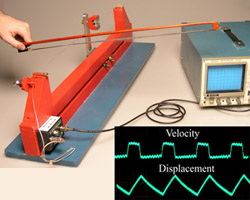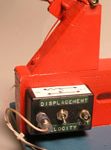
This demonstration shows the behavior of a bowed violin string.
The setup consists of the bowed string apparatus and an oscilloscope. The top picture shows the graphs of displacement and velocity of a bowed string. Its vibrations are very different from simple harmonic motion. Due to high static and low kinetic friction between the bow and string, the force applied by a player leads to a “stick and slip” motion which in turn distinguishes the bowed string’s rich tone and ability to sustain notes.
How it works:
When part of the string moves in a magnetic field, it generates a weak current. The current runs through a simple electronic circuit, and provides a signal displayed on an oscilloscope. The circuit has two modes: displacement and velocity. The string should be musically tuned before the demonstration.
Note: Apply liberal amounts of rosin to the bow

